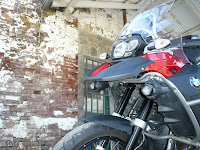Part 2 of a 3-part series.
CO-RIDER AND GOOD BUDDY RANDY BOEK comes from the private sector. Me? Public schools administration: 34 years. In real life, Randy is a leadership development expert. We’ve known each other for well over thirty-five years. Honest with each other to a fault, he lets me know when I’m full of it and, in return, I agree. Over dinner at the Diamondback Grill, we talked about leadership and both the private and public sector’s current dearth thereof. Talking about the day’s riding would have been much more satisfying. The conversation on the evening of the second day would be much different.
WHEN I LIVED IN TUOLUMNE COUNTY twenty years back, Washington Street boasted at least three breakfast joints, The Miner’s Shack, Wilma’s (nee: the Europa) and a place on the ground floor of the Sonora Inn. As things evolve, breakfast seems to no longer be the most important meal of the day and pastries at The Gunn House would have to suffice.
At the crack of 9:00 AM we boarded the BMWs. Choosing a non-state highway route, we wound through springtime on Lime Kiln, Algerine, Twist (aptly named) and Jacksonville Roads. Grasses approached knee depth. Pasturelands were quiet grazed by cattle, sheep, goats and llamas. The cool, dense morning was heavily ladened with the aroma of these livestock. It felt like country. Good country. A scenic overlook at Don Pedro reservoir invited a stop.
 |
| (click to expand) |
Gold seekers from throughout the world flocked to the narrow band of rolling hills from 1849 through the mid fifties and beyond. They built towns of brick and timber, many of which have returned to dust, some of which are mere place names and some of which still stand as reminders.
Arriving at Coulterville, we dismount for a close up look at the remnants of our heritage. A massive wisteria climbs through the second story porch at the Hotel Jeffrey, its trunk bigger in diameter than the posts supporting the veranda.
The streetscape includes the abandoned brick general store with evidence of its conversion to electricity. Our heels echo on the boardwalk that may have been first constructed at a time when roads turned from dust to mud in a matter of hours.
Placed at one end of town is Whistling Billy, a narrow gauge tank side engine, workhorse from the mining era through the lumbering era. An example of which was recently discovered up north within the basin of a drained Butt Lake (Plumas County) when the dam was retrofitted for seismic safety.
 |
| Mariposa C of C |
Oakhurst is at the southern foot of highway 49. On a whim, we skimmed along the ridge tops the route takes for its final nineteen miles. I hoped to park the bike under the marker reading California 49 with a rectangular sign reading “end.” There wasn’t one. There was that typical mix of brick and board buildings harkening back a century and a half. We lunched in Coarse Gold.
THE AFTERNOON found us racing westward through the foothills into the orchard plains of the San Joaquin Valley. Almonds. Pistachios. Citrus. And wind. Between Los Banos (so named “the baths” for pools in the area, not “the toilet”) at the east side of the Coast Range, a nasty north wind blew across our track. At highway speeds on route 152, it felt as if at any moment we could be plucked from one lane and deposited in the next. Or across the median. Up through the San Luis Reservoir, each time the road turned or crested a hill, we had to be ready to correct for windblast. Once over Pacheco Pass, the winds abated. Past Casa de Fruita, we pulled over swearing in general, but also swearing specifically that neither of us wanted to ride through such conditions again.
Over the ridges, skirting biker Mecca Hollister, we routed through San Juan Bautista, where Patty Reid’s doll resides at the state park. Names on the landscape are more Hispanic. The hills rolling, green and pastoral. It is understandable why Fr. Serra and his ilk found this land of milk and honey fit for civilizing. If one didn’t save a soul on a particular day, at least the weather would be pleasant.
Miles further, we connected with State Route 1 and, like Fremont a hundred and seventy years back, aimed for Monterey. A sunny spring day had warmed the coastal plain and the air mass above it lightened and rose. Furiously rushing in would be the cold, bitter air from over the Pacific. The winds of the San Joaquin became mere child’s play as we batted down 1, gripping the bike’s saddles in a manner we had not assumed our butts could actually grip, peppered by blowing sand, and greatly concerned that the next gust would blow us into the path of a passing Freightliner.
 |
| Google Images |
***
RESOURCES:
Gudde, Erwin G, California Place Names – the Origin and Etymology of Current Geographical Names, University of California Press, 1949, 1960, 1969, 1998.
Randy Boek (rhymes with “heck” or “wreck”) is a business consultant. He works in leadership development. He believes in the power of people working together toward clearly articulated and commonly understood goals. While much of his focus is on private sector success, there is much that he has to offer leaders in education and other public endeavors. For more information, see http://www.route2results.com/ His insightful blog may be found at http://randyboek.wordpress.com/





PA: For the first time ever, I'm familiar with everyplace in your blog :)
ReplyDelete